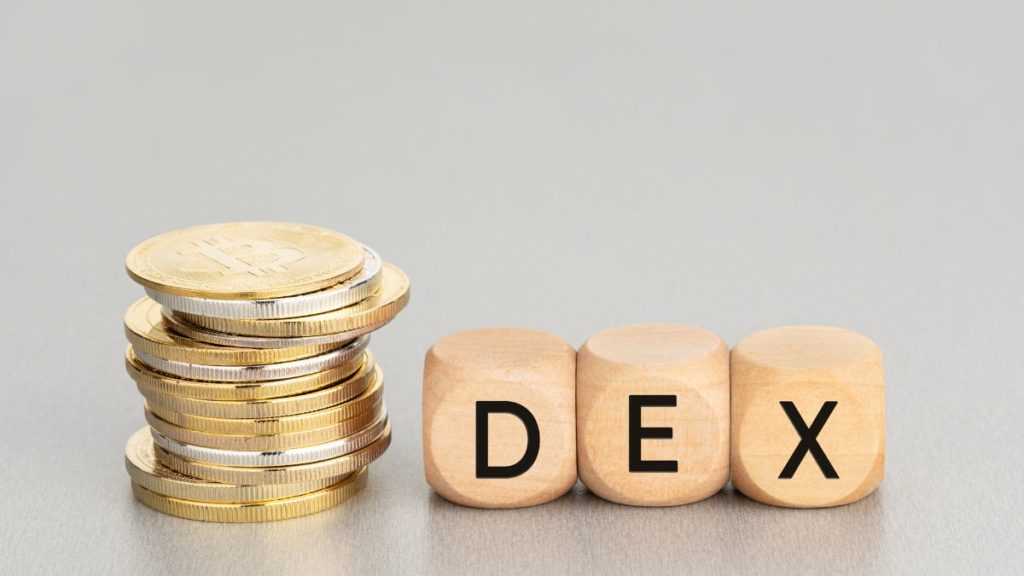Do you want to know whether to use CEX or DEX? Well, you’re at the right spot. As the title of the post suggests (CEX Vs DEX), this post will cover all the differences between these two types of exchanges, so you can decide which is better for you.
We’ll also recommend the best CEXs and best DEXs later, but first, let’s talk about CEXs Vs DEXs.
CEXs Vs DEXs
CEXs and DEXs have plenty of differences. By reading this section about CEXs Vs DEXs, you’ll become familiar with all of them.
Anonymity
The biggest difference you’ll find in this CEXs Vs DEXs comparison is anonymity. DEXs offer far greater anonymity than CEXs. This is because, unlike CEXs, they don’t make their users complete KYC and AML procedures.
Completing these procedures eliminates anonymity because the user has to give all sorts of personal information to the authorities. The users will have to provide at least some of the following information:
- Name
- Phone Number
- Official ID
- Permanent/Temporary Address
However, not following these procedures can be considered a double-edged sword. KYC and AML help prevent hackers and scammers from joining the exchange, and they make it easier to identify them after they have committed the fraud.
Nonetheless, the absence of KYC and AML shouldn’t be considered a downside for DEXs, because these exchanges are already quite secure, so they don’t need KYC and AML.
Wallets
When it comes to wallets, DEXs are doing far better than CEXs. All the DEXs offer non-custodial wallets, whereas, the majority of the CEXs don’t.
In case you’re not familiar with the non-custodial wallets, these are the wallets that provide keys to the owners. As for custodial wallets, the exchange gets custody of the private keys.
Since most CEXs offer custodial wallets, they own the private keys of the assets. The problem here is that in case the exchange gets hacked, the hacker can steal the users’ assets. This isn’t an issue for DEXs’ users because they own the private keys of their wallets.

Fiat to Crypto
The majority of the CEXs support fiat currencies, whereas, less than a fraction of DEXs support fiat. Therefore, you’ll need to purchase crypto to use DEXs.
The downsides are that this will make the process more time-consuming and it may even increase the trading cost.
Liquidity
Liquidity is the ability of the coin to be converted into cash or other coins without decreasing its value. The higher the number of coins an exchange has, the higher its liquidity.
The exchanges with high liquidity reap lots of benefits:
- The sellers could sell their assets at a competitive price
- Large trades will not cause volatility. The market will keep operating stably
- High liquidity means that a huge number of people are willing to buy and sell tokens. It means a token can be purchased or sold at a fast pace.
- A liquid market has a more developed and precise formation of prices, which leads to more accuracy with technical analysis.
CEXs have a much larger user base than DEXs, therefore, they have much higher liquidity than DEXs. Here are 3 reasons why they have a small user base.
- DEXs platforms are new, and they’ll need time to grow
- The transaction speed is quite slow
- The biggest reason is the difficulty in accessing the DEXs
User-Interface
When it comes to a user interface, CEXs are doing far better. This is mostly because getting access to CEXs is much easier than getting access to DEXs.
To access a CEX, you’ll need to provide some information such as name and email and purchase a wallet. Setting up the wallet will be incredibly simple because the exchange will take care of the complicated stuff.
When it comes to DEX, getting access is much more complicated. First, you’ll need a special browser that supports the DEX you want to use, and in case you want to use multiple DEXs then you may need multiple browsers. Second, you’ll need to set up the wallet yourself.
These tasks shouldn’t be difficult for a tech-savvy person, but for the vast majority of the population they are extremely difficult
Cost
When it comes to transaction costs, DEXs usually charge a lower fee. The reason is that they use smart contracts. Smart contracts are self-executing pieces of code that can process transactions without the assistance of any intermediary.
Since smart contracts get rid of intermediaries, DEXs can process transactions at a lower rate.
However, this isn’t always the case. Because many DEXs charge a higher transaction fee to compensate liquidity providers (LPs), the transaction cost for those exchanges could be even higher than many CEXs. Why do many exchanges increase the transaction fee to give higher rewards to the LPs? We’ll cover it in the next section.
Impermanent Loss
Impermanent loss means that the
LP’s token price at the time they exit the liquidity pool was lower than the time they entered the pool. Impermanent loss is much more common in DEXs than CEXs. This is due to the pricing system of DEX liquidity pools.
Now, let’s address the question that we promised to answer. DEXs need the liquidity of the LPs to run the liquidity pools. LPs provide liquidity for positive ROI but impermanent loss often leads to negative ROI.
Since impermanent loss is quite common in DEXs, it takes away the incentive of LPs to invest in the liquidity pool. To keep the LPs, many DEXs increase their transaction fee.
Speed
The transaction speed of most CEXs is much higher than DEXs. The reason for this is that many DEXs use miners for validating transactions.
To validate a transaction, miners have to solve the right hash. They usually have to generate billions of hashes until they find the right one, so the process can be quite time-consuming. The time is especially long for DEXs with a high number of miners.
Order Types
CEXs is winning in this area. The majority of DEXs allow traders to exchange, lend, and borrow. Some of them have them rolled out staking and stop-loss and take-profit orders, but the numbers are too little.
Every other CEX offers all these features, and many offer much more. Spot trading, leveraging, futures, and options are only some order types that you’ll find only on CEXs.

CEXs Vs DEXs: Which One Should You Choose?
Now it’s time to answer the biggest question in this CEXs Vs DEXs comparison. Which one should you choose?
The answer depends on your needs and preferences. You should use a DEX if any of these features are your priority:
- Anonymity
- Safety (from hackers and fraudsters)
- Low Transaction Cost
You should use a CEX if you find any of these features the most important:
- Ease of Accessibility
- Ease of Navigation
- Large Variety of Order Types
- Fast Transactions
- Fiat Availability
- More Precision For Technical Analysis
- No Negative Impact On Price By Large Transactions
However, it’s worth noting that these features aren’t set in stone. Some exchanges offer good features of both types of exchanges. To read more news about dexs and cexs you can visit https://algory.io/blog/
Best Centralized Crypto Exchanges
If you want to use a centralized exchange, then you’ll love this section. We are going to introduce you to some of the best CEXs in the world. All these exchanges have unique features, so read them all to find out which one is best for you.
Binance
Binance is the most popular crypto exchange and it has the highest trading volume.
The exchange supports over 174 currencies and offers 50 pairings. Binance has an incredibly low withdrawal fee and no deposit fee. It’s 0.1% for small transactions and it’s even lower for large transactions.
The transaction speed depends on the funding method you use. Here are the 3 funding methods supported by the exchange.
ACH: You can buy and sell using this method. Transactions are completed within 1-3 days.
Credit/Debit Card: You can buy but not sell. Transactions are completed instantly.
Wire Transfer: You can buy but not sell. Transactions are completed within 1-3 days.
Binance exchange has robust security protocols, and it offers insurance. The exchange was only hacked once, and they cover all the stolen amount with insurance funds.
You will find about any crypto product on Binance. Some of their popular products are staking, loans, credit cards, liquidity pools, and NFTs.
The Binance exchange has two drawbacks. First, it’s not the most regulated exchange. It does have to implement KYC and AML procedures, but it often doesn’t do a good job. The second drawback is that the main site is not available in the USA.
Crypto.com
If you like to trade cryptocurrencies through mobile phones, then crypto.com is a great option for you.
Unlike most exchanges, the mobile app of crypto.com has a super friendly user interface, and it allows the users to access the same features as the crypto.com’s website.
Crypto.com is available in 90 countries and it supports a staggering figure of cryptocurrencies (over 250!).
As for transaction fees, it’s doing great in this area. Transaction fees range from 0% to about zero percent (0.075%).
Crypto.com only supports wallets for withdrawal and deposits. Let’s look at the details of both methods.
The Wallet App: You can buy and sell using this method. Transactions are processed instantly.
External Wallet: You can buy and sell. Transactions are processed within 2-3 hours.
Crypto.com has a blockchain and a native token as well (CRO). The exchange offers cool products and features such as crypto visa cards and yield farming.
As for security, crypto.com has never been hacked so it’s doing good in this area as well.
There are downsides to crypto.com. First, their customer support isn’t often helpful and they respond slowly. Second, it doesn’t support fiat.
Coinbase
Coinbase is the safest centralized exchange in the world. Here are the major security features it offers:
- Stores 99% of the assets in the cold storage
- Supports 2-factor authentication
- Send a code for validating the phone number
- Allows the users to delete their information from the exchange’s server if they decide to delete the account
Coinbase supports over 100 currencies and it’s available in over 100 countries. Its transaction fee is a bit high, but not too much (flat 1℅ fee).
The exchange supports 4 paint methods.
Bank Account: You can use this method to buy and sell. Transactions are completed within 4-5 days.
Credit/Debit Card: You can buy but not sell. Transactions are completed instantly.
Wire Transfer: You can’t sell, but you can buy. Transactions are completed within 1-3 days.
PayPal: You can buy and sell using this method. Transactions are completed nearly instantly.
Kraken
Kraken is one of the most popular crypto exchanges in the world. It supports over 180 currencies and it’s available for almost every country in the world (176 countries).
The trading fee is 1.5% for crypto transactions, and 0.9% for stablecoin transactions. While the fee is quite high, it’s worth it if you consider the features the exchange offers.
You get a customizable chart analysis tool, an impressive variety of order types (13 order types), and amazing transaction speed for visa transactions.
Here are the three payment methods supported by Kraken.
Wire Transfer: You can’t buy but you can sell. Transactions are completed within 1-3 days.
Visa: You can use this method to buy and sell. Transactions are completed instantly.
MasterCard: You can buy but not sell. Transactions are completed nearly instantly.

Best Decentralized Crypto Exchanges
In this section, we are going to tell you everything you need to know about the 2 best DEXs in the world.
Bisq
Bisq supports over 120 currencies and it’s available for every single country.
The users don’t have to provide any personal information. All they have to do is connect their wallet, and start using Bisq.
The transaction fee is quite low. The maximum fee limit is 0.7% and the lowest limit is 0.1%.
The exchange has incredibly robust security protocols, and it hasn’t been hacked once. The customer support is quite helpful and responds promptly.
It’s one of the few DEXs that support fiat currencies. It supports over a dozen fiat currencies.
There are 3 payment methods.
ACH: You can buy and sell using this method. Transactions are completed within 1-3 days.
Wire Transfer: You can’t buy but you can sell. Transactions are completed within 1-3 days.
Credit/Debit: You can buy but not sell. Transactions are completed instantly.
Bisq has two downsides. The first one is its complex user interface. You’ll need to download multiple apps to access the exchange, and their website is hard to navigate.
The second drawback is that the liquidity for the majority of currencies is low. If someone makes a large transaction, millions of dollars, the value of the currency will decline. This rule doesn’t apply to ETH and a few other currencies.
Uniswap
Uniswap is the most popular DEX and it has the largest user base. It supports an astonishing number of 1,097 cryptocurrencies, but the even more impressive feature is that it supports 1,333 pairs.
The user interface of Uniswap is incredibly simple. From navigating the tools and products to accessing and learning how to use the exchange everything is super simple.
The exchange supports two payment methods.
Credit/Debit: You can buy but not sell. Transactions are completed instantly.
Paypal: You can buy and sell. Transactions are completed almost instantly.
The users of Uniswap are completely anonymous. No one knows even any minor detail about them.
The exchange has a liquidity pool, and it offers quite high profits.
Very stable pairs: 0.01%
Stable pairs: 0.05%
Most pairs: 0.30%
Exotic pairs: 1.00%
One more amazing thing about Uniswap is that it has higher liquidity than any other DEX. So, you won’t have to worry about the price of your crypto declining just because some rich person decided to sell their tokens.
Uniswap offers two more cool features. You don’t have to provide any information to use the exchange, and you can use the majority of the popular wallets.
Uniswap has two cons. First, It doesn’t support fiat currencies. The second con is its high fee. There is no fixed fee, and if you want to find out, you can go to the Uniswap trade tool.

